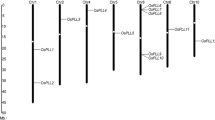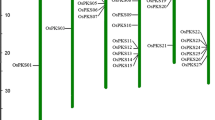Abstract
The rice low phytic acid 1 (lpa1) mutant was originally identified using a forward genetics approach. This mutant exhibits a 45% reduction in rice seed phytic acid with a molar-equivalent increase in inorganic phosphorus; however, it does not appear to differ significantly in productivity from its wild-type progenitor. A second lpa1 mutant was identified from additional screening for high seed inorganic phosphorus phenotypes. Using a positional cloning strategy, we identified a single candidate gene at the rice Lpa1 locus. Sequence analysis of the candidate gene from the lpa1 mutants revealed two independent mutations (a single base pair substitution and a single base pair deletion) that confirmed the identification of this candidate as the rice low phytic acid 1 gene, OsLpa1. The OsLpa1 gene has three splice variants. The location and nature of the two mutations suggests that these lesions only affect the translation of the predicted protein derived from the longest transcript. The proteins encoded by OsLpa1 do not have homology to any of the inositol phosphate metabolism genes recently characterized in plants, although there is homology to 2-phosphoglycerate kinase, an enzyme found in hyperthermophilic methanogens that catalyzes the formation of 2,3-bisphosphoglycerate from 2-phosphoglycerate. OsLpa1 represents a novel gene involved in phytic acid metabolism.







Similar content being viewed by others
References
Andaya CB, Tai TH (2005) Fine mapping of the rice low phytic acid (lpa1) locus. Theor Appl Genet 111:489–495
Aravind L, Wolf YI, Koonin EV (2000) The ATP-CONE: an evolutionarily mobile, ATP-binding regulatory domain. J Mol Microbiol Biotechnol 2:191–194
Bregitzer P, Raboy V (2006) Effects of four independent low-phytate mutations on barley agronomic performance. Crop Sci 46:1318–1322
Brinch-Pedersen H, Sorensen LD, Holm PB (2002) Engineering crop plants: getting a handle on phosphate. Trends Plant Sci 7:119–125
Chen PS, Toribara TY, Warner H (1956) Microdetermination of phosphorous. Anal Chem 28:1756–1758
Dorsch JA, Cook A, Young KA, Anderson JM, Bauman AT, Volkmann CJ, Murthy PPN, Raboy V (2003) Seed phosphorus and inositol phosphate phenotype of barley low phytic acid genotypes. Phytochem 62:691–706
Downes CP, Mussat MC, Michell RH (1982) The inositol trisphosphate phosphomonoesterase of the human erythrocyte membrane. Biochem J 203:169–177
Guttieri M, Bowen D, Dorsch JA, Raboy V, Souza E (2004) Identification and characterization of a low phytic acid wheat. Crop Sci 44:418–424
Hensel R, König H (1988) Thermoadaptation of methanogenic bacteria by intracellular ion concentration. FEMS Microbiol Lett 49:75–79
Hitz WD, Carlson TJ, Kerr PS, Sebastian SA (2002) Biochemical and molecular characterization of a mutation that confer decreased raffinosaccharide and phytic acid phenotype. Plant Physiol 128:650–660
Larson SR, Young KA, Cook A, Blake TK, Raboy V (1998) Linkage mapping 2 mutations that reduce phytic acid content of barley grain. Theor Appl Genet 97:141–146
Larson SR, Rutger JN, Young KA, Raboy V (2000) Isolation and genetic mapping of a non-lethal rice (Oryza sativa L.) low phytic acid 1 mutation. Crop Sci 40:1397–1405
Lehmacher A, Hensel R (1994) Cloning, sequencing and expression of the gene encoding 2-phosphoglycerate kinase from Methanothermus fervidus. Mol Gen Genet 242:163–168
Lehmacher A, Vogt AB, Hensel R (1990) Biosynthesis of cyclic 2, 3-diphosphoglycerate. Isolation and characterization of 2-phosphoglycerate kinase and cyclic 2, 3-diphosphoglycerate synthetase from Methanothermus fervidus. FEBS Lett 272:94–98
Leipe DD, Koonin EV, Aravind L (2003) Evolution and classification of P-loop kinases and related proteins. J Mol Biol 333:781–815
Lemtiri-Chlieh F, MacRobbie EAC, Brearley CA (2000) Inositol hexkisphosphate is a physiological signal regulating the K + -inward rectifying conductance in guard cells. Proc Natl Acad Sci USA 97:8687–8692
Lemtiri-Chlieh F, MacRobbie EAC, Webb AAR, Manison NF, Brownlee C, Skepper JN, Chen J, Prestwich GD, Brearley CA (2003) Inositol hexakisphosphate mobilizes an endomembrane store of calcium in guard cells. Proc Natl Acad Sci USA 100:10091–10095
Liu QL, Xu XH, Ren XL, Fu HW, Wu DX, Shu QY (2007) Generation and characterization of low phytic acid germplasm in rice (Oryza sativa L.). Theor Appl Genet 114:803–814
Lopez HW, Leenhardt F, Coudray C, Remesy C (2002) Minerals and phytic acid interactions: is it a real problem for human nutrition? Intl J Food Sci Technol 37:727–739
Lott J, Greenwood J, Batten G (1995) Mechanisms and regulation of mineral nutrient storage during seed development. In: Kigel J, Galili G (eds) Seed development and germination. Marcel Dekker, New York, pp 215–235
Mitsuhashi N, Ohnishi M, Sekiguchi Y, Kwon YU, Chang YT, Chung SK, Inoue Y, Reid RJ, Yagisawa H, Mimura T (2005) Phytic acid synthesis and vacuolar accumulation in suspension-cultured cells of Catharanthus roseus induced by high concentration of inorganic phosphate and cations. Plant Physiol 138:1607–1614
Pilu R, Panzeri D, Gavazzi G, Rasmussen SK, Consonni G, Nielsen E (2003) Phenotypic, genetic and molecular characterization of a maize low phytic acid mutant (lpa 241). Theor Appl Genet 107:980–987
Raboy V (1997) Accumulation and storage of phosphate and minerals. In: Larkin BA, Vasil IK (eds) Cellular and molecular biology of plant seed development. Kluwer , Netherlands, pp 441–477
Raboy V (2001) Seeds for a better future: ‘low phytate’ grains help to overcome malnutrition and reduce pollution. Trends Plant Sci 6:458–462
Raboy V (2007) The ABCs of low phytate crops. Nat Biotechnol 25:874–875
Raboy V, Dickinson DB, Below FE (1984) Variation in seed total phosphorus, phytic acid, zinc, calcium, magnesium, and protein among lines of Glycine max and G. soja. Crop Sci 24:431–434
Raboy V, Gerbasi PF, Young KA, Stoneberg SD, Pickett SG, Bauman AT, Murthy PPN, Sheridan WF, Ertl DS (2000) Origin and seed phenotype of maize low phytic acid 1–1 and low phytic acid 2–1. Plant Physiol 124:355–368
Rasmussen SK, Hatzack F (1998) Identification of two low-phytate barley (Hordeum vulgare L.) grain mutants by TLC and genetic analysis. Hereditas 129:107–112
Rutger JN, Raboy V, Moldenhauer KAK, Bryant RJ, Lee FN, Gibbons JW (2004) Registration of KBNT lpa1–1 low phytic acid germplasm of rice. Crop Sci 44:363
Sharpley AN, Charpa SC, Wedepohl R, Sims JY, Daniel TC, Reddy KR (1994) Managing agricultural phosphorus for protection of surface waters: issues and options. J Environ Qual 23:437–451
Shi JR, Wang HY, Wu YS, Hazebroek J, Meeley RB, Ertl DS (2003) The maize low-phytic acid mutant lpa2 is caused by mutation in an inositol phosphate kinase gene. Plant Physiol 131:507–515
Shi JR, Wang HY, Hazebroek J, Ertl DS, Harp T (2005) The maize low-phytic acid 3 encodes a myo-inositol kinase that plays a role in phytic acid biosynthesis in developing seeds. Plant J 42:408–419
Shi JR, Wang HY, Schelin K, Li BL, Faller M, Stoop JM, Meeley RB, Ertl DS, Ranch JP, Glassman K (2007) Embryo-specific silencing of a transporter reduces phytic acid content of maize and soybean seeds. Nat Biotechnol 25:930–937
Stevenson-Paulik J, Odom AR, York JD (2002) Molecular and biochemical characterization of two plant inositol polyphosphate 6-/3-/5-kinases. J Biol Chem 277:42711–42718
Stevenson-Paulik J, Bastidas RJ, Chiou AT, Frye RA, York JD (2005) Generation of phytate-free seeds in Arabidopsis through disruption of inositol polyphosphate kinases. Proc Natl Acad Sci USA 102:12612–12617
Sun Y, Thompson M, Lin G, Butler H, Gao Z, Thornburgh S, Yau K, Smith DA, Shukla VK (2007) Inositol 1, 3, 4, 5, 6-pentakisphosphate kinase from maize: molecular and biochemical characterization. Plant Physiol 144:1278–1291
Tai T, Tanksley S (1990) A rapid and inexpensive method for isolation of total DNA from dehydrated plant tissue. Plant Mol Biol Rep 8:297–303
Torre M, Rodrigues AR, Saura-Calixto F (1991) Effects of dietary fiber and phytic acid on mineral availability. Crit Rev Food Sci Nutr 1:1–22
Wilcox JR, Premachandra GS, Young KA, Raboy V (2000) Isolation of high inorganic P, low-phytate soybean mutants. Crop Sci 40:1601–1605
York JD (2006) Regulation of nuclear processes by inositol polyphosphates. Biochim Biophys Acta 1761:552–559
Yoshida KT, Wada T, Koyama M, Mizobuchi-Fukuoka R, Naito S (1999) Temporal and spatial patterns of accumulation of the transcript of myo-inositol phosphate synthase and phytin containing particles during seed development in rice. Plant Physiol 119:65–72
Yuan FJ, Zhao HJ, Ren XL, Zhu SL, Fu XJ, Shu QY (2007) Generation and characterization of two novel low phytate mutations in soybean (Glycine max L. Merr.). Theor Appl Genet 115:945–957
Acknowledgments
This was supported by National Research Initiative Competitive Grant 2005-35301-15708 from the USDA Cooperative State Research, Education, and Extension Service (T.H.T). We gratefully acknowledge technical assistance from P.M. Colowit and D. Farzaneh. We are also thankful to J.N. Rutger and V. Raboy for critical reading of the manuscript and helpful suggestions for improvement.
Author information
Authors and Affiliations
Corresponding author
Additional information
Communicated by Y. Xu.
S.I. Kim and C.B. Andaya contributed equally to this work. The mention of trade names or commercial products in this publication is solely for the purpose of providing specific information and does not imply recommendation or endorsement by the U.S. Department of Agriculture.
Rights and permissions
About this article
Cite this article
Kim, S.I., Andaya, C.B., Goyal, S.S. et al. The rice OsLpa1 gene encodes a novel protein involved in phytic acid metabolism. Theor Appl Genet 117, 769–779 (2008). https://doi.org/10.1007/s00122-008-0818-z
Received:
Accepted:
Published:
Issue Date:
DOI: https://doi.org/10.1007/s00122-008-0818-z




